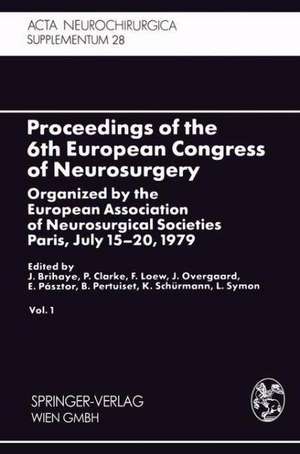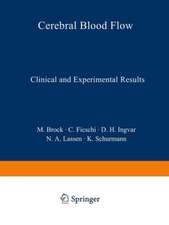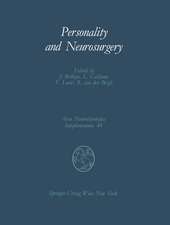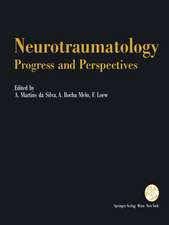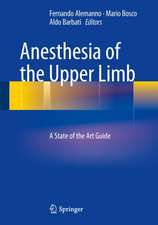Proceedings of the 6th European Congress of Neurosurgery: Organized by the European Association of Neurosurgical Societies Paris, July 15–20, 1979. Vol. 1: Acta Neurochirurgica Supplement, cartea 28
Editat de J. Brihaye, P. R. R. Clarke, F. Loew, J. Overgaard, E. Pasztor, B. Pertuiset, K. Schürmann, L. Symonen Limba Engleză Paperback – 20 noi 2013
Din seria Acta Neurochirurgica Supplement
- 5%
 Preț: 1798.83 lei
Preț: 1798.83 lei - 5%
 Preț: 1445.88 lei
Preț: 1445.88 lei - 5%
 Preț: 1102.31 lei
Preț: 1102.31 lei - 5%
 Preț: 1136.85 lei
Preț: 1136.85 lei - 5%
 Preț: 811.16 lei
Preț: 811.16 lei - 5%
 Preț: 1112.70 lei
Preț: 1112.70 lei - 5%
 Preț: 529.81 lei
Preț: 529.81 lei - 5%
 Preț: 791.25 lei
Preț: 791.25 lei - 5%
 Preț: 1303.26 lei
Preț: 1303.26 lei - 5%
 Preț: 410.88 lei
Preț: 410.88 lei - 5%
 Preț: 345.71 lei
Preț: 345.71 lei - 5%
 Preț: 1316.08 lei
Preț: 1316.08 lei - 5%
 Preț: 1452.28 lei
Preț: 1452.28 lei - 5%
 Preț: 1348.49 lei
Preț: 1348.49 lei - 5%
 Preț: 370.94 lei
Preț: 370.94 lei - 5%
 Preț: 376.22 lei
Preț: 376.22 lei - 5%
 Preț: 715.00 lei
Preț: 715.00 lei - 5%
 Preț: 364.17 lei
Preț: 364.17 lei - 5%
 Preț: 365.82 lei
Preț: 365.82 lei - 5%
 Preț: 366.91 lei
Preț: 366.91 lei - 5%
 Preț: 384.08 lei
Preț: 384.08 lei - 5%
 Preț: 397.16 lei
Preț: 397.16 lei - 5%
 Preț: 367.64 lei
Preț: 367.64 lei - 5%
 Preț: 373.12 lei
Preț: 373.12 lei - 5%
 Preț: 993.13 lei
Preț: 993.13 lei - 5%
 Preț: 394.07 lei
Preț: 394.07 lei - 5%
 Preț: 364.74 lei
Preț: 364.74 lei - 5%
 Preț: 1095.90 lei
Preț: 1095.90 lei - 5%
 Preț: 1824.10 lei
Preț: 1824.10 lei - 5%
 Preț: 1119.31 lei
Preț: 1119.31 lei - 5%
 Preț: 1312.12 lei
Preț: 1312.12 lei - 5%
 Preț: 1119.68 lei
Preț: 1119.68 lei - 5%
 Preț: 1331.78 lei
Preț: 1331.78 lei - 5%
 Preț: 1430.72 lei
Preț: 1430.72 lei - 5%
 Preț: 1405.49 lei
Preț: 1405.49 lei - 5%
 Preț: 1418.48 lei
Preț: 1418.48 lei - 5%
 Preț: 392.25 lei
Preț: 392.25 lei - 5%
 Preț: 1335.46 lei
Preț: 1335.46 lei - 5%
 Preț: 1375.23 lei
Preț: 1375.23 lei
Preț: 370.74 lei
Preț vechi: 390.25 lei
-5% Nou
Puncte Express: 556
Preț estimativ în valută:
70.96€ • 77.11$ • 59.65£
70.96€ • 77.11$ • 59.65£
Carte tipărită la comandă
Livrare economică 21 aprilie-05 mai
Preluare comenzi: 021 569.72.76
Specificații
ISBN-13: 9783709140901
ISBN-10: 3709140900
Pagini: 332
Ilustrații: XI, 315 p. 108 illus.
Dimensiuni: 155 x 235 x 17 mm
Greutate: 0.47 kg
Ediția:Softcover reprint of the original 1st ed. 1979
Editura: SPRINGER VIENNA
Colecția Springer
Seria Acta Neurochirurgica Supplement
Locul publicării:Vienna, Austria
ISBN-10: 3709140900
Pagini: 332
Ilustrații: XI, 315 p. 108 illus.
Dimensiuni: 155 x 235 x 17 mm
Greutate: 0.47 kg
Ediția:Softcover reprint of the original 1st ed. 1979
Editura: SPRINGER VIENNA
Colecția Springer
Seria Acta Neurochirurgica Supplement
Locul publicării:Vienna, Austria
Public țintă
ResearchCuprins
Prognostic Assessment of Coma in Relation to Age.- Adding up the Glasgow Coma Score.- Protocol for Reception, Management, and Assessment of Head Injuries.- Eye Movements as a Prognostic Factor.- The Clinical Criteria in Gravity Assessment of Acute Head Injuries Associated With Coma.- Combined Clinical and EEG Examinations for Assessment of Severity of Acute Head Injuries.- Using the Spectral Analysis of the EEG for Prognosis of Severe Brain Injuries in the First Post-Traumatic Week.- Prognostic Aspects of Electroclinical and Neuroendocrine Data in Severe Brain Injury.- Early Prognosis After Severe Human Head Injury Utilizing Multimodality Evoked Potentials.- Heart Rate Studies in Association With Electroencephalography (EEG) as a Means of Assessing the Progress of Head Injuries.- Prognostic Information From EEG and ICP Monitoring After Severe Closed Head Injuries in the Early Post-Traumatic Phase.- Symptoms of Temporal Lobe Contusions in the Early Period Post-Trauma.- Significance of Intracranial Pressure and Neurological Deficit as Prognostic Factors in Acute Severe Brain Lesions.- Prognostic Value of the Intracranial Pressure Levels During the Acute Phase of Severe Head Injuries.- The Prognostic Value of Intracranial Pressure Monitoring After Severe Head Injuries.- Prognostic Signs During Continuous Monitoring of the Ventricular Fluid Pressure in Patients With Severe Brain Injury.- CT, EEG, and ICP Recordings During Intensive Care of Acute Head Injuries.- CT Scan, ICP, and Early Neurological Evaluation in the Prognosis of Severe Head Injury.- Post-Traumatic Acute Rise of ICP Related to Subclinical Epileptic Seizures.- Serum Myelin Basic Protein, Clinical Responsiveness, and Outcome of Severe Head Injury.- The Significance of Cerebral and Systemic Disseminated Intravascular Coagulation in Early Prognosis of Brain Injury.- Disseminated Intravascular Coagulation Related to Outcome in Head Injury.- Prognostic Significance of the Changes in the Carbohydrate Metabolism in Severe Head Injury.- CKBB-Isoenzymes as a Sign of Cerebral Injury.- Disturbances of the Carbohydrate Metabolism in Acute Head Trauma.- The Prognostic Value of Osmolality Within the First Week of Sustaining Head Injury.- Post-Traumatic Amnesia, Post-Concussional Symptoms, and Accident Neurosis.- Burdens Imposed on the Relatives of Those With Severe Brain Damage Due to Injury.- The Nature of Physical, Mental and Social Deficits Contributing to the Categories of Good Recovery, Moderate and Severe Disability in the Glasgow Global Outcome Scale.- Long-Term Prognosis After Severe Head Injury.- Factors Determining Prognosis in Acute Subdural Haematoma.- Factors Influencing the Outcome of Coma in Severely Injured Patients.- Age and Outcome of Severe Head Injury.- Early Prognosis of Severe Head Injuries in Children.- Prognosis in Diffuse Injury.- Prognosis in Patients With Severe Head Injury.- Prognostic Factors in Acute Head Injuries—Brain Stem Contusion During the First Week.- Prognosis of the Individual Patient With Severe Head Injury.- Predicting the Outcome of Individual Patients in the First Week After Severe Head Injury.- Head Injury Prognosis: Calculations From Clinical Data.- Predicting Outcome After Severe Head Injury—A Computer-Assisted Analysis of Neurological Symptoms and Laboratory Values.- Risk Factors in Severe Head Injury.- The Prediction of Outcome of Patients Admitted Following Head Injury in Coma With Bilateral Fixed Pupils.- Forecasting Peculiarities of Intracerebral Pressure and Local Cerebral Blood Flow Data and Methods of Outcome Forecasting in theEarly Postoperative Period.- Sleep Alterations During Post-Traumatic Coma as a Possible Predictor of Cognitive Defects.- Assessment of Outcome Following Large Decompressive Craniectomy in Management of Serious Cerebral Contusion.- Outcome of Acute Subdural Haematoma Following Decompressive Hemicraniectomy.- Early Surgical Treatment of Traumatic Intracranial Haematomas and Laceration Foci as the Main Factor for Favourable Prognosis.- Local CBF in the Laceration Focus in Patients With Craniocerebral Trauma.- Brain Injuries—Causes of Death, and Life Expectancy.- On Comparing Series of Head Injured Patients.- Effect of Therapy on Prognosis of Cerebral Contusions.- The Assessment of the Efficacy of Different Therapies for Severe Head Injuries.- Phenomena Associated With Focal Ischaemia in the Central Nervous System.- Experimental Cerebral Hypoxia and Ischaemia in Cats.- Experimental Middle Cerebral Artery Embolization and Embolectomy.- Pentothal Protection for Delay Cerebral Revascularization.- Techniques of End-To-Side Anastomosis—Experimental Evaluation and Clinical Findings.- A New Technique for End-To-Side Anastomosis Between Small Arteries.- A Scanning Electron Microscopic (SEM) Study of the Re-Endothelialization of the Carotid End-To-Side Anastomosis in the Rat.- Scanning Electron Microscopy of the Endothelial Surface of Small Diameter Vein Grafts in Rats Treated With Heparin.- Venous Patch in Arteries of 1 mm External Diameter.- Application of Magnetobiological Effects in Restorative Cerebral Angiosurgery.- Microvascular Repair With Neodymium-YAG Laser.- Surgical Possibilities in the Third Portion of the Vertebral Artery (Above C2).- Assessment of Regional Cerebral Blood Flow Using the XE-133 Inhalation Method in Patients Undergoing EIAB Surgery.- CorticalArterial Pressure in Extra-Intracranial Anastomosis.- Animal Experiments With Doppler Flow Transducers.- The Role of Anastomoses in Brain Circulation.- Cerebral Revascularization With Extra-Intracranial Anastomoses for Vascular Lesions of Traumatic Malformative, and Tumours Origin.- Prevention of Brain Stem Stroke by Microvascular Anastomosis.- The Importance of the Early Diagnosis of Preocclusive Carotid Artery Lesions.- Microsurgical Approach to Bilateral Carotid Artery Occlusion.- Tandem Lesions of the Internal Carotid Arteries and Their Management.- Multiple Angiographic Studies and Tri-Dimensional Assessment of Regional Cerebral Perfusion on Patients Treated by EC-IC Bypass.- ExtraIntracranial Cerebral Anastomosis Operation in Acute Ischaemia as an Emergency.- EICA in Transient Ischaemic Attacks and Neurological Deficits.- Extra-Intracranial Anastomosis in Patients With Completed Strokes.- Effect of Extra-Intracranial Arterial Bypass (EIAB) on Cerebral Circulation and EEG.- Advantage of Using Hyperbaric Oxygenation (HO) in Combination With Extra-Intracranial Arterial Bypass (EIAB) in the Treatment of Completed Stroke.- Six Hundred Endovascular Neurosurgical Procedures in Vascular Pathology.- Endovascular Method of Excluding From the Circulation Saccular Cerebral Arterial Aneurysms, Leaving Intact Vessels Patient.
